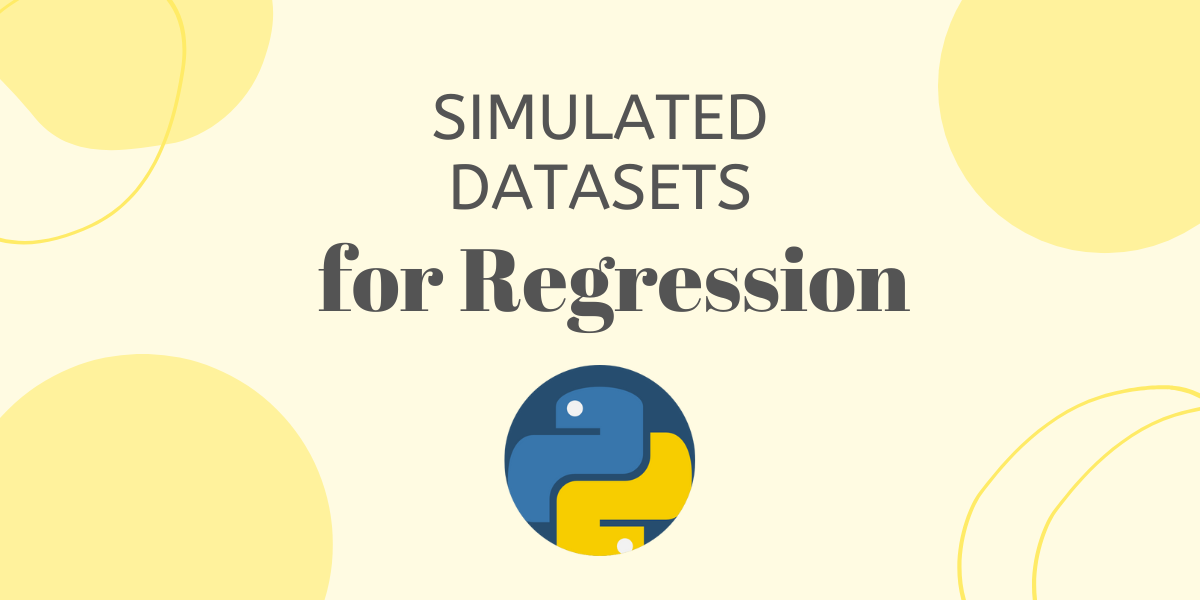Imagine that you want to replicate a dataset based on a specific behavior. You already know that data should perform a quadratic equation with the minimum in x = 500 with positive values. However, is there any way to simulate a similar scenario with Python?
This tutorial aims to learn how to create a sample dataset for regression problems. I will be covering linear regression and non-linear regression equations (polynomic, exponential…). I will continue updating this tutorial with new regression problems in the future. You can find the notebook for this tutorial on my GitHub account.
Linear Regression
Simple Regression
As you might know, linear regression is based on linear equations with the following form:
y = ax + b
where a is the slope and b is the cut in the y-axis.
To build a linear equation, an option is to use the function make_regression() from the Sklearn library to create samples of X and Y. The mean parameters you can add to this function are:
- n_sample: number of samples
- n_features: number of variables
- n_informative: number of informative variables to create the output
- n_targets: number of regression targets
- noise: standard deviation of the output
- random_state: the seed to control the randomness of the output
You can take a look at the rest of the parameters on the Sklearn documentation.
First of all, let’s import the libraries:
import pandas as pd
import numpy as np
import seaborn as sns
from sklearn import datasets
import matplotlib.pyplot as plt
from sklearn.datasets import make_regressionNow, let’s apply the make_regression() function:
x, y = datasets.make_regression(n_samples = 200, n_features = 1,
n_informative = 1, n_targets = 1,
noise = 20, random_state=12345, effective_rank=None)If you want to determine in which range X and Y values are moving, you can use a Numpy function called np.intern() specifying the minimum and the maximum for each one:
x = np.interp(x, (x.min(), x.max()), (3876, 15678))
y = np.interp(y, (y.min(), y.max()), (1678, 5435))Let’s plot the function to see what it looks like:
plt.ion()
plt.plot(x,y,'.')
Non-linear Regression
Polynomial Regression
In the case of polynomic regression, we need to apply a more complex methodology. For this example, I will be calculating a cubic equation. So, we are looking for an equation that has the following form:
y = ax^3 + bx^2 + cx + d
First, let’s determine the X coordinates of the maximum and the minimum values that we want to build the first derivative of our desired function.
To build my function for this specific exercise, I will use max_x = 3000 and min_y = 5000.
Then, create the factorial function based on those values. In this case, it will be the following one:
f'(x) = (x – 3000)(x – 5000)
After developing, we have the following equation:
f'(x) = x^2 – 8000x + 1.5·10^7
As I said, this is the first derivative. To get our cubic equation, it’s necessary to integrate using the Scipy and Sympy libraries. Let’s import them:
import scipy as sp
from sympy import *Now, I will create the symbol for X as it will be our unknown factor:
init_printing(use_unicode=False, wrap_line=False)
x = Symbol('x')In the next step, I will integrate the first derivative to get the cubic equation:
integrate(x**2 - 8000*x + 1.5*(10**7), x)This is the result of the integral that will be the base to build our cubic equation:
y = 1/3x^3 − 4000x^2 + 15000000x
All equations have different types of transformations.
- The first one is changing the D value. This will move the function up and down over the coordinate axis.
- The second one is to multiply or divide the whole function to stretch or flatten it.
Let’s plot the resultant equation to see what it looks like by defining a function:
def plot_me(a, b, c, d):
x = np.arange(0, 7000, 0.05)
y = [(a*i**3 + b*i**2 + c*i + d) for i in x]
plt.plot(x, y, label='cubic', linestyle='-')
plt.grid(True)
plt.show(block=False)
plt.pause(10)
plt.close()
plot_me(1/3, -4000, 15000000, 0)
Let’s do some transformations over the equation, so the range for the Y value is between 0 and 5000. To do so, I will divide the whole equation by 1500000. Also, I will move it 3000 units up (this means d = 3000).
plot_me(0.3333333/15000000, -4000/15000000, 15000000/15000000, 3000)
In the next post, I will share with you how to do a similar approach with exponential and logarithmic equations.

